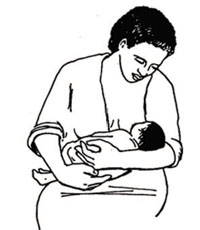Possible feeding options for an infant born to an HIV-positive mother
For you to be able to advise an HIV-positive mother you need to be able to advise them of the risks involved in each feeding option, and explain why exclusive breastfeeding for six months is the recommended option in low-resource settings.
Mixed feeding
Studies have shown that mixed feeding carries both a risk of HIV transmission from mother to child and a high risk of malnutrition. Therefore you must counsel parents to avoid mixed feeding and continue either with exclusive breastfeeding or exclusive replacement feeding.
Exclusive replacement feeding
The use of exclusive replacement feeding (using commercial infant formula) eliminates the transmission of HIV from breastfeeding. Exclusive replacement feeding means that the mother completely avoids breastfeeding her baby. However, as you read earlier, there are risks as well as benefits associated with exclusive replacement feeding. These are set out in the Box below.
Exclusive replacement feeding
Risks
- Increased risk of serious diarrhoeal infections and malnutrition leading to higher rates of early death
- Inadequate supply of formula leading to mixed feeding, increasing the risk of MTCT
- Formula feed is often diluted, improperly mixed, given inconsistently or prepared with unclean water
- There is an absence of protective factors in formula.
Benefits
- Less likelihood of HIV transmission from mother to child if entirely exclusive replacement feeding.
Because of the difficulties of exclusive replacement feeding, avoidance of breastfeeding is not safe in countries with limited resources.
Exclusive breastfeeding
Several studies have demonstrated that babies who are exclusively breastfed are at a lower risk of acquiring HIV infection compared with infants who have mixed feeding. However, there are risks associated with exclusive breastfeeding.

HIV is present in the breastmilk of infected mothers and can be transmitted to infants by breastfeeding. This poses a substantial risk for acquisition of HIV infection for the infant. Women with advanced disease are at highest risk of transmitting the virus to their babies during breastfeeding.
Prolonged breastfeeding (e.g. up to the age of 24 months) can increase the overall risk of mother-to-child transmission.